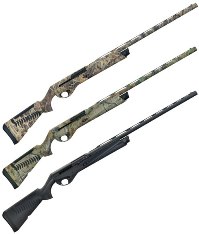|
How To Choose Your First Firearm - Part 2
Learn more about first firearms topics Part 1:Firearm Buying Basics and Youth Firearms 
Part 3:Hunting, Skeet, Trap and Target Shooting, Assault Rifles Personal Protection  The
best hand gun for personal protection for a first time shooter is a
semi-automatic 9mm pistol. Most 9mm are fairly inexpensive ($500
to $700) and offer sufficient knock down power with recoil that most
novices can quickly learn handle well. Yes, we all remember
Dirty Harry’s Magnum. It was very flashy, but not very functional for
most personal protection uses.
(Click photos to enlarge.)
The
best hand gun for personal protection for a first time shooter is a
semi-automatic 9mm pistol. Most 9mm are fairly inexpensive ($500
to $700) and offer sufficient knock down power with recoil that most
novices can quickly learn handle well. Yes, we all remember
Dirty Harry’s Magnum. It was very flashy, but not very functional for
most personal protection uses.
(Click photos to enlarge.)
Remember, you want easy motions in a small package that you can draw and fire quickly at close range to stop someone so you can get away or get help. In his book Seven Myths or Gun Control , Richard Poe lays out statistics that a potential victim is more likely to survive an attack by simply showing a gun and that it is a minority of the time that the gun is ever fired. So finding a hand gun that fits your ability and carrying situation is most important. Learn more about handgun point shooting.  As for a particular model, consider the Austrian made
Glock
19.
The Glock 19, a choice of many law enforcement departments, is a
tough, reliable pistol available with a 15 round magazine and double
action light pull trigger. The 4-inch barrel and weight distribution
makes recoil easier to control and reacquisition of the target faster
and easier than many other 9mm pistols.
As for a particular model, consider the Austrian made
Glock
19.
The Glock 19, a choice of many law enforcement departments, is a
tough, reliable pistol available with a 15 round magazine and double
action light pull trigger. The 4-inch barrel and weight distribution
makes recoil easier to control and reacquisition of the target faster
and easier than many other 9mm pistols.
The Glock 19 may, however, be too large for concealed carry. If you are looking for a concealed carry weapon, then consider a shorter model, such as the Glock 27 which is a .40 caliber shorter version of the same design. Learn more about hand gun ammunition . |
||
|
Women and Handguns
:
We have all seen You Tube videos of a woman not able to handle the recoil of a large caliber hand gun - such as the Desert Eagle .50 caliber. When you look more closely, you see they are inexperienced and being set up; that's not really funny and it is very dangerous.  Based on the average woman's size, weight and upper body strength, there is a balance of power and size most women need to consider more than most men. A novice woman shooter may shy away from a hand gun with enough knock down power to be effective, but don't go too small; a .22 is less likely to stop an attacker on the first shot. Likewise, it is not difficult with enough practice to learn to manage the recoil of larger caliber hand guns, but don't go too big; we don't won't controlling the gun to become work. The balance of intuitive actions, ease of use and knockdown power remain our primary objective for all novice handgun shooters.
Learn more about handgun point shooting.
Based on the average woman's size, weight and upper body strength, there is a balance of power and size most women need to consider more than most men. A novice woman shooter may shy away from a hand gun with enough knock down power to be effective, but don't go too small; a .22 is less likely to stop an attacker on the first shot. Likewise, it is not difficult with enough practice to learn to manage the recoil of larger caliber hand guns, but don't go too big; we don't won't controlling the gun to become work. The balance of intuitive actions, ease of use and knockdown power remain our primary objective for all novice handgun shooters.
Learn more about handgun point shooting.
Home Protection The best overall firearm for home protection for the first time shooter is the shot gun ($300 to $500), and here's why. Home protection firearms will be used in close quarters, likely within a room in your home or on your property. The situation will be stressful and likely at night with poor lighting which will make complicated handling or accurate aiming difficult. You may need to concentrate on communication at the same time as you are handling your gun. So for home protection we want a "point and shoot" firearm that is easy to operate, which is just how a shot gun works. Learn more about shotgun gauge and ammunition. For this use, you want the most power with a shorter barrel with no chokes to get the maximum spread of shot over the shortest distance - which describes a "tactical" 12-gauge. If you are not comfortable with the recoil of a 12-gauge (which can leave a bruise), a 20-gauge still has enough knock down power with much more comfortable recoil. You will need to choose between a semi-automatic (which cycles out the spent shell and reloads the gun automatically) or a manual operation, which will most often be a pump action. Semi-automatics are very good for home protection, but can jam at the wrong time if not well maintained. Pump actions are most common for tactical shot guns, but you do need to remember to reload after each shot, which can be a trained reflex with a little practice. More about Shotguns Shotguns offer the greatest variety of shooting options, including various sizes of pellet (or shot) for various types of hunting, as well as firing a single "bullet" or slug. Shotguns can have smooth bore (for pellets) or rifled barrels for slugs. The sights on the smooth bore can be one or more beads on the barrel and the aiming is “point-and-shoot” since the multiple pellets in the shot gun shell spread apart when fired. The rifled barrel can be aimed with bead sights as well, or can be equipped with a scope for better shot placement if you are firing a slug (single large "bullet" fired from a shotgun. You can often find deals on new shotguns that include both barrel types, various chokes and sometimes scopes for the rifled barrel. Learn more about shotguns for hunting and skeet shooting. Many experienced shooters prefer the knock down power of a 12-gauge, but the recoil can be difficult for a novice, so starting with a 20-gauge which provides the same versatility with more comfortable recoil may be a good idea. Although you loose is some knock down power downsizing to the 20-gauge, some compensations can be made with chokes and choices of ammunition. Learn more about shotgun gauge and ammunition.  Just about any brand name pump action should serve you well. We’re partial to the Mossberg 500 pump action for the American made quality, solid performance and wide range of option packages including classic wood stock, camouflage and tactical configurations. Plus, the Mossberg 500 Persuader 12-gauge is the tactical pump action used by the Navy Seals.
(Click photos to enlarge.)
Just about any brand name pump action should serve you well. We’re partial to the Mossberg 500 pump action for the American made quality, solid performance and wide range of option packages including classic wood stock, camouflage and tactical configurations. Plus, the Mossberg 500 Persuader 12-gauge is the tactical pump action used by the Navy Seals.
(Click photos to enlarge.)
|
||

|
||

Custom Search
|
||



